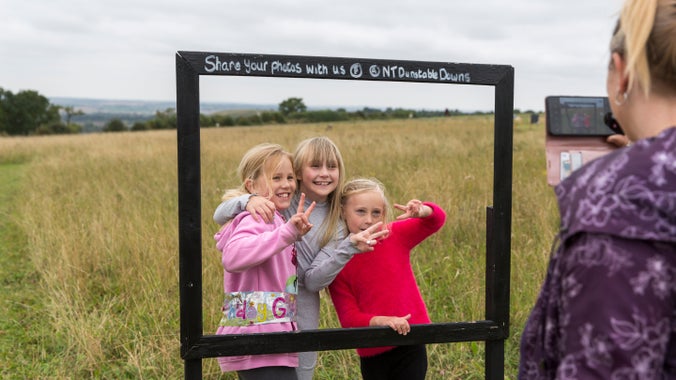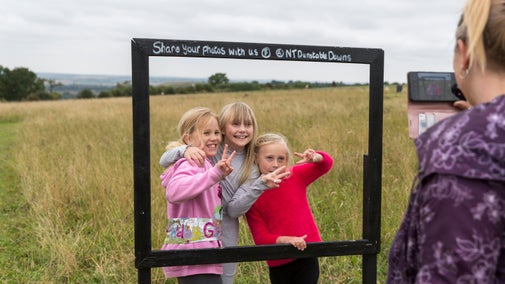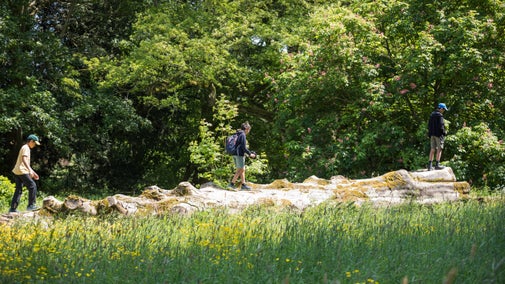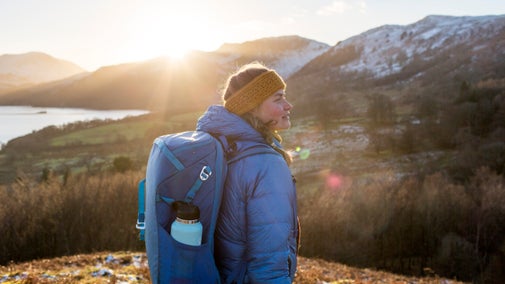
Discover more at Dunstable Downs and Whipsnade Estate
Find out when Dunstable Downs and Whipsnade Estate is open, how to get here, the things to see and do and more.

Chalk grassland is full of life and you may need to look closely, but there are hundreds of weird and wonderful minibeasts within this habitat at Dunstable Downs. The ridge is the ideal place for flying your kite and there are miles of chalk grassland for you and your dog to explore. Here’s a snapshot of what to look out for and things to do when you’re visiting Dunstable Downs.
Work is underway to extend the multi-use trail at Dunstable Downs to provide a surfaced circular route from the Gateway Visitor Centre to and around Chute Wood. The all-weather path will connect with the existing path at the windcatcher viewpoint and will improve accessibility for all visitors including wheelchair users, pushchairs, cyclists and walkers to some of the more sheltered areas of the Downs. The work is expected to continue until November and while the impact on visitors should be limited, at times it will be necessary to close off some areas.
Looking to get the children outside and entertained this October Half Term? We have plenty of fun activities, check them out here.
Maybe it's too early for us to mention the C-word but we know many of you like to get organised, so check out our festive programme here.

Check our events page to see what activities are happening during your visit here.
Formed when humans cleared land of trees and shrubs to graze livestock, chalk grasslands are home to a huge range of species and are comparable to rainforests in their biodiversity. You can find up to 40 species per square metre of grassland in this habitat.
Red kites breed in April and can have as many as five different nests in their territory. They’ll use the same nests many times and live on average for 10 years.
You'll recognise the red kite by its unmistakable silhouette and fork-like tails, which twist to help them change direction like a ship's rudder.

The adults are 60-70cm long with a wingspan of nearly two metres. Red kites are scavengers and steal food from other birds in mid-air. The females are slightly larger than the males and will pair for life. They’ve thrived in Britain since their reintroduction in 1989, especially across the Chilterns, and we’re lucky enough to have red kites soaring over Dunstable Downs.
The windswept ridge provides ideal conditions for a variety of air sports, especially kite flying. On calmer days it's the ideal site to enjoy the view and a picnic. You can buy a kite in the shape of a red kite, in the visitor centre shop.
The countryside team managing the chalk grassland at the Bison Hill site, have discovered slow-worms here, one of six reptile species native to the UK.
Despite their name and appearance, they're neither worm nor snake, but in fact a legless lizard.
They are distinguished from snakes by a number of differences. Slow-worms, like all lizards, have eyelids in the form of semi-transparent scales which allow them to blink. Trickier to spot are the ear openings and the centrally notched tongue, which is different to the classic forked snake tongue.
Interestingly, many lizards such as the slow-worm have one lung smaller than the other for reasons that are as yet unclear. In slow-worms, the left lung is much smaller than the right.

Slow-worms range in colour, from grey-brown to gold or copper depending on their age and gender. Juveniles are gold with dark brown bellies and sides, with a dark stripe along the spine.
Females are larger and have a subtle coppery sheen, with a stripe along the spine and black stripes down the side. Males are paler in colour and may display electric blue dorsal (top) spots.
Competition between males is brutal as they fight intensely with each other. It’s thought that their blue spots help the males to appeal to females at breeding time. This is a risky strategy as it makes them easily spotted by predators.
Many plants will only grow in chalk grassland. Dunstable Downs have many varieties of stunning wild orchids. The orchids and other wildflowers attract a wide variety of butterflies and is home to 32 species, including the rare Duke of Burgundy butterfly.
We are delighted to introduce our sensory bags, available to borrow from 22 July 2024. With a great selection of sensory items to provide stimulation, create calm, and engage with your senses, these can be curated and signed in and out from our Visitor Welcome Hub. They are to help visitors with autism, sensory processing disorder, or those who think they would benefit from them during their visit.
There are two different options for visiting Dunstable Downs with schools, self-led visits or led classes. Any visits by schools must book in with us prior to arriving.
Come along and lead your own school group, using our permitted paths and agreed areas. Coaches can drop off and pick up but are not allowed to park up. Please be aware that we do not have any bag drop facilities or sheltered lunch/learning space.
- Email us at dunstabledowns@nationaltrust.org.uk to request a booking form for self-led school visits.
If you would prefer to leave the teaching to someone else, then Fraxini provide taught schools’ sessions at Dunstable Downs. The sessions are run by experienced, DBS-checked, trained teachers and are suitable for all age groups. The activities are closely linked to the National Curriculum requirements for KS1 and KS2 but can be adjusted to work for secondary pupils too. Please be aware that we do not have any bag drop facilities or sheltered lunch/learning space.
Orienteering
-a half-day activity plotting coordinates on a map and then using the coordinates and map to find letters, pictures or puzzles (depending on age).
Bespoke
-we can plan days to suit you, to match your topic or learning journey.
To find out more and book your trip, email us: fraxini@btinternet.com
All organised events must be discussed and booked in with us prior to arriving. Groups will be asked to provide relevant risk assessments and public liability insurance as well as a donation to the estate. To enquire about an event, please email dunstabledowns@nationaltrust.org.uk.
We can accommodate Pick-ups and Drop-offs at Dunstable Downs. Depending on group size, we can offer one of our overflow carparks to facilitate this.
Permitted walking routes across Dunstable Downs are available to use for expeditions.
Any use of Dunstable Downs for DofE events and school groups must be pre-booked and the relevant risk assessments and public liability insurance shown to sign off the event. We also ask for a donation to be made to Dunstable Downs for any drop off and pick up bookings to help cover conservation efforts across the estate as well as upkeep of our spaces including car parks and visitor toilets.
To enquire about a DofE event, please email dunstabledowns@nationaltrust.org.uk.

Find out when Dunstable Downs and Whipsnade Estate is open, how to get here, the things to see and do and more.
There are loads of different family activities designed to help you explore and discover Dunstable Downs. However you choose to spend your day with us, your adventure starts here.

Unearth the history at Dunstable Downs, with the Five Knolls Neolithic burial mounds, an exciting medieval past, and the extraordinary events that took place at Pascombe Pit.

Enjoy stunning views and tempting treats in the café’s large indoor and outdoor seating areas. Discover seasonal and locally sourced gifts in the shop for a souvenir of your visit.

Dunstable Downs is a two pawprint rated place. Dogs are welcome here (and can collect their Pooch Passport and stamp!) Discover everything you need to know when planning your visit with your four-legged friend.

Plan a visit to one of the special countryside places in our care and discover the benefits of being in the great outdoors. Pack your walking boots and get ready to explore woodlands, valleys and rivers.

Explore an ancient forest, acres of chalk grassland and other hidden countryside spaces around Essex, Bedfordshire and Hertfordshire.

Explore some of the finest landscapes in our care on coastal paths, accessible trails, woodland walks and everything in between. Find the best places to walk near you.
